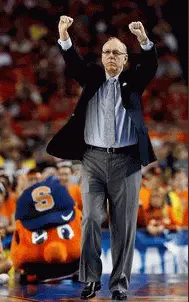Basketball Defense - Zone Defense
By Dr. James Gels, from the Coach’s Clipboard Basketball PlaybookMore Reading on Zone Defense
Zone defense is often effective in stopping dribble penetration and one-on-one moves. On a personal note, I believe that all kids must develop their man-to-man defensive skills first. I believe youth basketball leagues should limit the use of zones to the older age groups.
On the other hand, some high school and college coaches treat zone defense almost as if using it were blasphemous, or an admission of inferiority! At the upper levels, I believe you should assess your team's strengths and weaknesses as well as your opponent's, and the game situation, and use whatever tool you need to try to win.

Syracuse's Jim Boeheim is
famous for his 2-3 zone
Advantages of zone defense
1. Not all teams have good, quick man-to-man defenders. Or the offense may have a couple of outstanding players too quick to defend individually. Playing a zone can help in these situations. Zone defense has been called "a great equalizer" in making up for lack of quickness. You may have a tall, strong, but not particularly quick team. A zone can look intimidating with all your big guys stacked up inside.
If you play man-to-man defense and have very short guards, the opponent will run screens to get switches and size mis-matches against your small guards near the basket. You can avoid this by playing zone defense, keeping your small players out on the perimeter.
2. No lay-ups, stop dribble-penetration. In using a zone, you protect the paint area and force the opponent to shoot from outside. An example would be using the 2-3 zone which clogs the paint and invites the offense to shoot from outside. Use it to see if the opponent can shoot from outside consistently. Even good shooting teams have off nights, especially under tournament pressure.
3. Generally fewer fouls occur with zone defense. If you are playing man-to-man and your team is in foul trouble, especially your big man, switch to a zone to help protect him.
4. You can slow the game and control the tempo somewhat with a zone.
5. Opponents tend to become impatient against the zone and often rush shots.
6. Most youth and high school players are just average passers, and have difficulty making good inside passes and accurate skip passes.
7. By changing defenses from man-to-man to various zones, you can keep the offense off-balance and confused.
8. If you use a full-court or half-court press, after the press is broken, it is easy to drop back into a half-court zone defense.
9. Compared to man-to-man offenses, there are far fewer zone offenses to contend with, and zone defense can easily be adapted to counter the opponent's best player(s). Opposing coaches tend to spend much more practice time on attacking man-to-man defense than they do on zones. As a result, lots of good teams struggle against zone defenses.
10. If you play zone defense exclusively (no man-to-man), you can save practice time (for your offense and other things) as zone defense is easier to teach.
Disadvantages of zone defense
1. If your team is behind, you won't get pressure on the ball, and the offense can stall and hold the ball for a good shot. You must go man-to-man in this situation.
2. If the opponent is having a good shooting night, your zone is not effective, and you must consider going man-to-man to get pressure on perimeter shooters.
3. There are not always clear-cut rebounding box-out assignments and sometimes the offensive player will slip inside for the offensive rebound and lay-up. See Zone Rebounding for help with this.
4. If you play zone most of the time, and rarely man-to-man, your players may become complacent on defense and may lose their man-to-man skills. I would practice man-to-man 80-90% of the time, and zone the remaining 10-20%.
Basic pointers for all zone defenses
1. No lay-ups. Try to keep the ball outside. Double-team the ball in the paint.
2. Be vocal, talk to each other.
3. Move quickly, adjust your position relative to the movement of the ball. Move quickly on the flight of the ball, as soon as it leaves the passer's hands.
4. Get your hands up and out, to shrink the passing lanes.
5. Close-out on the shooter with high hands, to pressure the shot and the pass. We are less concerned with dribble-penetration since the zone creates too much congestion inside for the dribble-drive.
6. Stay in your defensive stance. This is especially important for weakside defenders. The weakside low defender should keep his "butt to the baseline" so that he can see the floor, and any cutters or screeners coming his way.
7. No fouls. Play good defense without fouling.
8. No second shots. Be aggressive rebounders.
9. When the offense dribble penetrates, quickly close the gap.
10. Get to know your opponent and adjust. Over-protect against the best shooters, or the "hot" shooter, and sag off the guy who never shoots.
11. Trap the corners.
12. Especially if you are ahead, don't gamble or get too zealous about trapping the wing and point guard positions. Keep pressure on the ball, but also protect the paint and force the outside, low-percentage shot.
Related pages:
- 2-3 zone defense
- Aggressive 2-3 Zone Defense
- Breakdown Drills for Teaching the 2-3 Zone Defense
- 1-2-2 zone defense (and 3-2)
- 1-3-1 zone defense
- 1-1-3 Zone Defense
- Amoeba Defense
- Point-Zone Defense
- Match-up zone defense